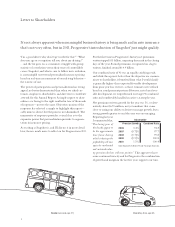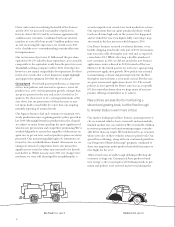Progressive 2011 Annual Report Download - page 18
Download and view the complete annual report
Please find page 18 of the 2011 Progressive annual report below. You can navigate through the pages in the report by either clicking on the pages listed below, or by using the keyword search tool below to find specific information within the annual report.
Objectives, Policies, and Operations Summary
OBJECTIVES
Profitability
Progressive’s most important goal is for our
insurance subsidiaries to produce an aggregate calendar-
year underwriting profit of at least 4%. Our business is a
composite of many product offerings defined in part by
product type, distribution channel, geography, customer
tenure, and underwriting grouping. Each of these products
has targeted operating parameters based on level of maturity,
underlying cost structures, customer mix, and policy life
expectancy. Our aggregate goal is the balanced blend of
these individual performance targets in any calendar year.
Growth Our goal is to grow as fast as possible, constrained
only by our profitability objective and our ability to provide
high-quality customer service. Progressive is a growth-
oriented company and management incentives are tied to
profitable growth.
We report Personal Lines and Commercial Auto results
separately. We further break down our Personal Lines’
results by channel (Agency and Direct) to give shareholders
a clearer picture of the business dynamics of each distribu-
tion method and their respective rates of growth. Aggregate
expense ratios and aggregate growth rates disguise the true
nature and performance of each business.
FINANCIAL POLICIES
Progressive balances operating risk with risk of investing
and financing activities in order to have sufficient capital to
support all the insurance we can profitably underwrite and
service. isks arise in all operational and functional areas, and
therefore must be assessed holistically, accounting for the
offsetting and compounding effects of the separate sources
of risk within Progressive.
We use risk management tools to quantify the amount of
capital needed, in addition to surplus, to absorb consequences
of events such as unfavorable loss reserve development,
litigation, weather-related catastrophes, and investment-
market corrections. Our financial policies define our
allocation of risk and we measure our performance against
them. If, in our view, future opportunities meet our financial
objectives and policies, we will invest capital in expanding
business op erations. Underleveraged capital will be returned
to investors. We expect to earn a return on equity greater than
its cost. Presented is an overview of Progressive’s Operating,
Investing, and Financing policies.
Consistent achievement of superior results requires that our people understand Progressive’s
objectives and their specific roles, and that their personal objectives dovetail with Progressive’s.
Our objectives are ambitious, yet realistic. Progressive monitors its financial policies con-
tinuously and strives to meet these targets annually. Experience always clarifies objectives
and illuminates better policies. We constantly evolve as we monitor the execution of our
policies and progress toward achieving our objectives.
OPERATING
Monitor pricing and reserving discipline
– Manage profitability targets and operational performance at our
lowest level of product definition
– Sustain premiums-to-surplus ratios at efficient levels, and at or
below applicable state regulations, for each insurance subsidiary
– Ensure loss reserves are adequate and develop with minimal
variance
INVESTING
Maintain a liquid, diversified, high-quality investment portfolio
– Manage on a total return basis
– Manage interest rate, credit, prepayment, extension, and
con centra tion risk
– Allocate portfolio between two groups:
Group I – Target 0% to 25% (common equities; nonredeemable
preferred stocks; redeemable preferred stocks, except for
50% of investment-grade redeemable preferred stocks with
cumulative dividends; and all other non-investment-grade fixed-
maturity securities)
Group II – Target 75% to 100% (short-term securities and all
other fixed-maturity securities)
FINANCING
Maintain sufficient capital to support insurance operations
– Maintain debt below 30% of total capital at book value
– Neutralize dilution from equity-based compensation in the year
of issuance through share repurchases
– Return underleveraged capital through share repurchases,
extraordinary dividends, and a variable dividend program based
on annual underwriting results
19
Impala (Xeno, age 31)
























